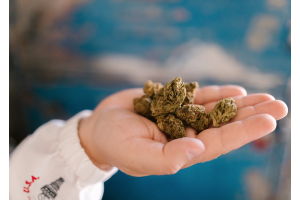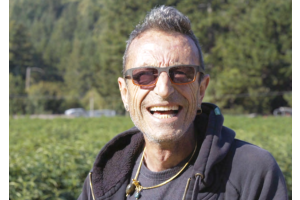Folk Medicine Practitioners In Bangladesh relied on the Ethnomedicinal Benefits

Cannabis is a hot topic, but most news sprouts out of North America and Europe. Because of this, the publication of a recent report into the ethnomedicinal usage of cannabis in Bangladesh has stirred up plenty of interest.
Located in the eastern segment of India on the Bay of Bengal, this South Asian country is recognizable from its vibrant greenery and natural water sources. Boat transportation is popular in Bangladesh, which is renowned for being home to the Jamuna, Meghna and Padma rivers. So untouched is the natural landscape that Bangladesh's southern coast serves as home for the royal Bengal tiger.
Wildlife aside, it seems that Bangladesh has also been a hotspot for cannabis-growing over the years. Despite the fact that the sale, purchase, possession, transportation and cultivation of cannabis has been outlawed since the 1980s, a new report published in the Journal of Cannabis Research suggests that local folk medicine practitioners used the plant as traditional phytomedicine.
Origins, bans Historic documents indicate that both cannabis and opium have traditionally been relied on by the Bangladeshi people. In fact, the locals – along with West Bengal natives and foreigners – tend to puff the herb at an annual event in Kushtia, Bangladesh. The special occasion that celebrates the memory of the late folk musician Fakir Lalon Shah.
Interestingly, although the plant is illegal, the yearly event sees attendees indulge in cannabis as a way of connecting to one another spiritually while basking in the ambience of Lalon Shah-inspired music. Even though cannabis consumption is tolerated at the festival, law enforcement officials are always on-guard to ensure nothing goes wrong. To this day, cannabis consumption remains to be a popular habit among the local people. Nonetheless, the plant's popularity has not stopped the government from trying to completely banish cannabis from its fertile lands.
Back in 1987, the Bangladesh government – which, at that period in time, was dictated by Ershad – conspired with former U.S. President, Ronald Reagan to prohibit cannabis cultivation. Nowadays, the Narcotics Control Act 1990 influences current laws pertaining to cannabis in Bangladesh. Based on details of the Act, the courts are granted power to penalize people caught with more than two kilograms of cannabis by death sentence.
Ethnomedicinal usage
The Bangladeshi government continues to impose harsh restrictions on cannabis sale and cultivation. Nonetheless, consumption of Cannabis sativa as a natural phytomedicine has been widely practiced traditionally by the country's folk medicine practitioners of Bangladesh throughout history. The team of researchers responsible for carrying out this study assessed more than 200 ethnomedicinal plant survey articles. They discovered that Bangladeshi folk medicine practitioners (FMP) from 12 distinct districts used Cannabis sativa to treat a broad spectrum of ailments, including the following:
Sleep-associated problems
Infections and respiratory problems
Neuropsychiatric and CNS problems
Rheumatism
Gastrointestinal problems
Gynecological problems
Cancer
Sexual problems
Hypertension
Headache
Skin itching
Bile secretion
Dandruff/dry scalp
Abortifacient
Fever
Urinary problems
In total, 15 types of cannabis formulations were recognized from 11 out of 18 ethnomedicinal plant assessment reports. Researchers noted the percentage when highlighting the most commonly-used parts of the plant, which were as follows:
Leaf - 53.8 percent
Root - 23 percent
Seed - 7.7 percent
Flower, resin, inflorescence and all other parts - 3.8 percent, respectively.
While Cannabis sativa boasts ethnomedicinal qualities in the traditional folk medicine of Bangladesh, more biological research must be carried out to ascertain the pharmacological potential of cannabis and cannabinoid use across the country. Once this has been confirmed, the outlook for cannabis biomedicine and safety is sure to be much brighter.
Science Suggests that Cannabis Is Highly Medicinal
Although the medicinal benefits of medical cannabis remain widely unknown and deserve further research, scientists have confirmed that the leafy green plant contains hundreds of active compounds. Better known as "cannabinoids", these naturally-occurring compounds each have a different purpose.Two of the most widely-studied components are the psychoactive compound THC (tetrahydrocannabinol) and the non-psychotropic compound CBD (cannabidiol). However, more than 100 cannabinoids have been identified so far.
Consumers can administer cannabis and cannabinoids in various ways, with two of the most tried-and-tested methods being oral consumption and inhalation in the form of smoking or vaping. The method of administration determines how quickly cannabis is absorbed into the bloodstream, before it reacts with receptors in the endocannabinoid system (ECS). Scientists have determined that cannabinoids may possess analgesic, anti-inflammatory and anxiolytic effects. However, every cannabinoid is different and therefore each person's experience will depend on the chosen strain.
Cannabis Cultivation in Bangladesh
According to the 2005 UNODC Bangladesh country profile, cannabis continues to be cultivated across the country. Some of the most high-profile states for cannabis cultivation in Bangladesh are the districts of Jamalpur, Naogaon, Rajshahi and Netrokona; all of which are located in the northwestern region. In addition to this, farmers are renowned for illegally growing the plant in Cox’s Bazar, Bandarban, Rangamati and Khagrachari. Although it remains uncertain as to the precise area of land on which cannabis is produced in Bangladesh, an increasing number of growers are believed to be operating in the Chittagong Hill Tract region.
Cannabis-Focused Research Is Ongoing
A qualitative study that was previously carried out into "Cannabis smoking and its social impact in a village of Bangladesh" drew attention to the lack of studies into cannabis' impact on village societies. All participants who partook in the study, of which there were 23 in total, resided in Chandly village under Godagari Upazila in the Rajshahi region of Bangladesh.
The researchers practiced a "snowball sampling technique" and carried out in-depth interviews as a way of collecting data. By utilizing a semi-structured questionnaire, the researchers were able to accurately gather and analyze the data. They also performed thematic analysis and adopted the MS Excel platform to log descriptive statistics.
According to the outcome of their study, interviewees had a mean age of 39 years and the main age of cannabis consumption by means of smoking was 17.30 years. Almost half of the study subjects were getting their fingers dirty with agriculture - 43.48%.The most common unfavorable incidents of cannabis consumption were as follows:
negative social perception (78.26%)
bad familial relationship (56.5%)
suffering from different types of health problems (43%)
occupational problems (21.74%)
loss of education (17.39%)
involvement with crimes (9%)
Furthermore, the study determined that cannabis consumption influences people to take other types of illegal substances, such as:
alcohol (43.78%)
heroine (13.04%)
fencidil (4.35%)
yaba (4.35%)
Conclusion
This study indicates that further research and multi-approach strategies must be carried out into cannabis to help prevent any negative social consequences pertaining to the plant’s use and production in Bangladesh.
The Drug Enforcement administration (DEA) recently progressed with the reviewing of medical cannabis research applications for scientists who are interested in finding out more about the plant's potential in the medical sector.
On Friday, May 14, the Agency declared that it had sent memorandums of agreement (MOAs) to hopeful cultivators “outlining the means by which the applicant and DEA will work together to facilitate the production, storage, packaging, and distribution of marijuana under the new regulations."
Written and Published Bethan Bee Rose in Weed World Magazine issue 154
PHOTO BY BANGLADESH NATURE FROM PEXELS












Validate your login